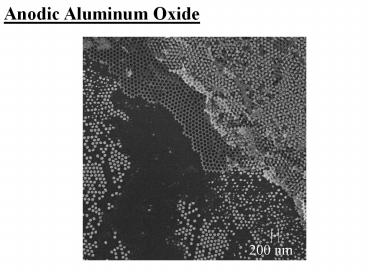Anodic Aluminum Oxide
Title:
Anodic Aluminum Oxide
Description:
Fabricate ordered arrays of structures on the nanometer scale using porous alumina templates. ... Why do we want to fabricate nanostructures? ... –
Number of Views:1629
Avg rating:3.0/5.0
Title: Anodic Aluminum Oxide
1
Anodic Aluminum Oxide
2
Introduction
Objective
Fabricate ordered arrays of structures on the
nanometer scale using porous alumina templates.
3
Motivation General
What is Anodic Porous Alumina?
- Aluminum oxide grown on an Al substrate in an
electrolytic cell. The resulting structure
consists of an array of tunable nanometer-sized
pores surrounded by an alumina backbone.
Purpose
- To understand the mechanisms involved in the
growth and ordering of anodic porous alumina.
Motivation
- Interest in using anodic porous alumina as a
nano- template to fabricate nanometer-sized
structures (e.g. nanofabrication of quantum dots).
Why do we want to fabricate nanostructures?
1. Fundamental physical interest in the
nanometer size regime. Properties of nano-sized
structures are different from their bulk and
molecular counterparts. 2. Technological
applications as electronic and optical devices.
4
Motivation Applications
Commercially available Anopore filter.
http//www.2spi.com/catalog/spec_prep/filter2.html
1. Physics
- Explore optical, electrical, and magnetic quantum
confinement.
2. Engineering
- Microfiltration.
- Optical waveguides and photonic crystals for
optical circuits. - Template for carbon nanotube growth for
electronic, mechanical applications. - Ordered arrays of quantum dots for lasers,
photodetectors. - ULSI memory devices and ICs.
Porous Alumina used as optical waveguide. H.
Masuda, et. al., Jpn. J. Appl. Phys. 38, L1403
(1999).
Ordered arrays of carbon nanotubes fabricated
using a porous alumina template. J. Li, et al.,
Appl. Phys. Lett. 75(3), 367 (1999).
5
Overview of Anodic Oxide Films
Fabrication
- Anodize aluminum in electrolyte
- (e.g. Oxalic Acid)
Two main types of anodic oxide films can be grown
depending on the nature of the electrolyte
- 1. Barrier-Type Films
- Grown Oxide Insoluble in Electrolyte
- Nearly Neutral Electrolytes (pH 5-7)
- 2. Porous-Type Films
- Grown Oxide Slightly Soluble in Electrolyte
- Aqueous Sulfuric, Oxalic, and Phosphoric Acid
Electrolytes
6
Porous Alumina
Apparatus
- Anodize aluminum in electrolyte (e.g. Oxalic
Acid). - Oxide grows at the metal/oxide and
oxide/electrolyte interfaces, pores initiate at
random positions by field-assisted dissolution at
the oxide/electrolyte interface. - Ordering requires appropriate potentials and long
anodization times. - Ordering results from repulsion between
neighboring pores due to mechanical stress at the
metal/oxide interface.
Resulting Structure
H. Masuda and K. Fukuda, Science 268, 1466 (1995).
7
Overview of Film Anodization
- Oxide growth proceeds via ionic conduction and
reaction of Al cations and oxygen containing
anions under the influence of an applied field.
(e.g.
2Al 3OH- ? Al2O33H6e-) - Pores initiate at random positions through
field-assisted dissolution of the oxide at the
oxide/electrolyte interface.
- Initially oxide growth dominates. (I)
- Dissolution becomes competitive, barrier layer
thins, and pores initiate. (II) - Approaches steady state where both mechanisms
occur at roughly the same rate. (III and IV)
V.P. Parkhutik, and V.I. Shershulsky, J. Phys.
DAppl. Phys. 25, 1258 (1992).
8
Ordered Nano-Templates
- Tunable diameters and spacings from 20 nm to 500
nm. - Polycrystalline structure ordered micron-sized
domains, defects at grain boundaries. - Low temperature growth produces unordered 4-10 nm
arrays.
9
Ordered Growth of Porous Alumina
- Ordered pore arrays obtained in three different
electrolytes for long anodization times and
appropriate voltages (specific for each
electrolyte). - Polycrystalline structure with perfectly ordered
domains a few microns in size. Defects occur at
grain boundaries.
10
Thermally Evaporated Nano-Dots Gold
- Porous alumina used as an evaporation mask to
grow quantum dots.
H. Masuda et al. , Jpn. J. Appl. Phys. 35, L126
(1996).
11
Overview Mask Processing
1. Anodize sample for a long time to achieve
ordered pores.
1.
2. Chemically remove the alumina in a mixture of
phosphoric and chromic acid.
2.
AFM of Unopened Barrier Layer (1 mm x 1 mm)
3. Anodize sample for a short time.
3.
4. Coat top surface of alumina with a polymer
(collodion) to protect it from further processing.
4.
5.
5. Remove Al Substrate in a saturated HgCl2
solution.
6.
6. Remove the barrier layer in 5 wt. Phosphoric
Acid.
7.
7. Remove collodion and place alumina on desired
substrate.
H. Masuda et al. , Jpn. J. Appl. Phys. 35, L126
(1996).
12
Procedure Anodization
- Apply black wax around the area that you want to
anodize. - Electropolish Aluminum surface to make it smooth.
- Anodize the sample that should be ordered for 15
hours in oxalic acid. - Anodize the sample that should be disordered for
1 hour in oxalic acid.
13
Procedure Anodization (cont.)
- Chemically remove the alumina in a mixture of
phosphoric and chromic acid. - Anodize both samples for one hour in oxalic acid.
- Coat top surface of alumina with a polymer
(collodion) to protect it from further
processing.
14
Procedure Anodization (cont.)
- Remove Al substrate in a saturated HgCl2
solution. - Use a piece of silicon to pick up oxide and
polymer and move to 5 wt. phosphoric acid. This
removes barrier layer. - Remove collodion and place alumina on desired
substrate- silicon for SEM characterization and
quartz for UV-Vis characterization.
15
Procedure Thermal Evaporation
- Thermally Evaporate Gold onto all Samples
- Must be done one sample at a time, because
alignment is critical. - Gold layer should be 50nm thick.
- Remove AAO with double stick tape.
16
Results AFM Characterization- disordered Au dots
17
Results AFM Characterization- ordered Au dots
18
Results SEM Characterization- silicon substrate
Ordered AAO (100k magnification)
Unordered AAO (100k magnification)
Unordered Au dots (100k magnification)
Ordered Au dots (100k magnification)
19
Results UV-Vis Characterization- quartz substrate
- Place drop of magic oil on microscope slide to
get rid of Newtons rings - Place sample in spectrophotometer. Scan from 300
to 1200nm.































